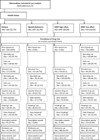Dynamics in the costs of criminality among opioid dependent individuals
- PMID: 25282307
- PMCID: PMC4456021
- DOI: 10.1016/j.drugalcdep.2014.09.007
Dynamics in the costs of criminality among opioid dependent individuals
Abstract
Background: Research into the avoided crime-related costs associated with methadone maintenance treatment (MMT) is sparse. Our objective was to characterize the dynamics in crime-related costs associated with MMT effectiveness among opioid dependent individuals in Vancouver, Canada.
Methods: We considered individuals enrolled in a prospective study between December, 2011 and May, 2013. Monthly crime-related costs (2013 CAD) were derived from self-reported criminal activity. On the basis of MMT receipt and illicit opioid use, individuals were classified in mutually exclusive health states: (i) MMT high effectiveness; (ii) MMT low effectiveness; (iii) opioid abstinence; or (iv) relapse. We classified individuals as daily, non-daily or non-stimulant users and controlled for demographic and socio-economic characteristics. A two-part multiple regression model was constructed; the first part modeled non-zero cost probability, the second estimated the level of costs. Avoided costs were estimated for each health state and stratified by stimulant use intensity.
Results: Our study included 982 individuals (median age 47, 38% female) for 2232 observations. Individuals on MMT with high effectiveness incurred lower monthly costs of criminality (avoided costs of $6298; 95% C.I. ($1578, $11,017)), as did opioid abstinent individuals ($6563 ($1564, $11,561)). Avoided costs for daily stimulant users were greater than for non-daily users, both for individuals on MMT with high effectiveness ($12,975 vs. $4125) and opioid abstinent ($12,640 vs. $4814).
Conclusion: Using longitudinal data on individuals with a history of MMT, we found substantially lower costs of criminality associated with high effect to MMT. Avoided costs were highest among daily stimulant users that were on MMT with high effectiveness or those opioid abstinent.
Keywords: Costs of criminality; Methadone maintenance treatment; Opioid use; Relapse; Stimulant use; Treatment outcomes.
Copyright © 2014 Elsevier Ireland Ltd. All rights reserved.
Conflict of interest statement
Dr. Julio Montaner has received grants from Abbott, Biolytical, Boehringer Ingelheim, Bristol-Myers Squibb, Gilead Sciences, Janssen, Merck and ViiV Healthcare.
Figures


Similar articles
-
The costs of crime associated with stimulant use in a Canadian setting.Drug Alcohol Depend. 2017 Nov 1;180:304-310. doi: 10.1016/j.drugalcdep.2017.08.026. Epub 2017 Sep 14. Drug Alcohol Depend. 2017. PMID: 28942287 Free PMC article.
-
Use of opioid substitution therapies in the treatment of opioid use disorder: results of a UK cost-effectiveness modelling study.J Med Econ. 2017 Jul;20(7):740-748. doi: 10.1080/13696998.2017.1325744. Epub 2017 May 25. J Med Econ. 2017. PMID: 28489467
-
The economic costs of jail-based methadone maintenance treatment.Am J Drug Alcohol Abuse. 2018;44(6):611-618. doi: 10.1080/00952990.2018.1491048. Epub 2018 Jul 19. Am J Drug Alcohol Abuse. 2018. PMID: 30024783
-
Medication-assisted treatment with methadone: assessing the evidence.Psychiatr Serv. 2014 Feb 1;65(2):146-57. doi: 10.1176/appi.ps.201300235. Psychiatr Serv. 2014. PMID: 24248468 Review.
-
The role of the Chinese police in methadone maintenance therapy: a literature review.Int J Drug Policy. 2013 Nov;24(6):e25-34. doi: 10.1016/j.drugpo.2013.03.010. Epub 2013 Apr 25. Int J Drug Policy. 2013. PMID: 23623719 Review.
Cited by
-
The costs of crime associated with stimulant use in a Canadian setting.Drug Alcohol Depend. 2017 Nov 1;180:304-310. doi: 10.1016/j.drugalcdep.2017.08.026. Epub 2017 Sep 14. Drug Alcohol Depend. 2017. PMID: 28942287 Free PMC article.
-
Estimating State Transitions for Opioid Use Disorders.Med Decis Making. 2017 Jul;37(5):483-497. doi: 10.1177/0272989X16683928. Epub 2016 Dec 27. Med Decis Making. 2017. PMID: 28027027 Free PMC article.
-
The costs of crime during and after publicly funded treatment for opioid use disorders: a population-level study for the state of California.Addiction. 2017 May;112(5):838-851. doi: 10.1111/add.13729. Epub 2017 Feb 6. Addiction. 2017. PMID: 27981691 Free PMC article.
-
Data Resource Profile Update: The Opioid Agonist Treatment and Safety II (OATS II) Study, 2001-22, New South Wales, Australia.Int J Epidemiol. 2025 Feb 16;54(2):dyaf037. doi: 10.1093/ije/dyaf037. Int J Epidemiol. 2025. PMID: 40187894 Free PMC article. No abstract available.
-
Unit Costs of Delinquent Acts for Use in Economic Evaluations.J Ment Health Policy Econ. 2019 Jun 1;22(2):71-79. J Ment Health Policy Econ. 2019. PMID: 31319377 Free PMC article.
References
-
- Bayer P, Hjalmarsson R, Pozen D. Building criminal capital behind bars: peer effects in juvenile corrections. Q. J. Econ. 2009;124:105–147.
-
- Bell J, Burrell T, Indig D, Gilmour S. Cycling in and out of treatment; participation in methadone treatment in NSW, 1990–2002. Drug Alcohol Depend. 2006;81:55–61. - PubMed
-
- Best D, Sidwell C, Gossop M, Harris J, Strang J. Crime and expenditure amongst polydrug misusers seeking treatment the connection between prescribed methadone and crack use criminal involvement. Br. J. Criminol. 2001;41:119–126.
-
- Bovasso G, Cacciola J. The long-term outcomes of drug use by methadone maintenance patients. J. Behav. Health Serv. Res. 2003;30:290–303. - PubMed
Publication types
MeSH terms
Substances
Grants and funding
LinkOut - more resources
Full Text Sources
Other Literature Sources
Medical
Miscellaneous

